8 Types of Ceiling Cracks, Fixes, & When to Worry
Author: Rick Worst | Editor: Omar Alonso
Review & Research: Jen Worst & Chris Miller
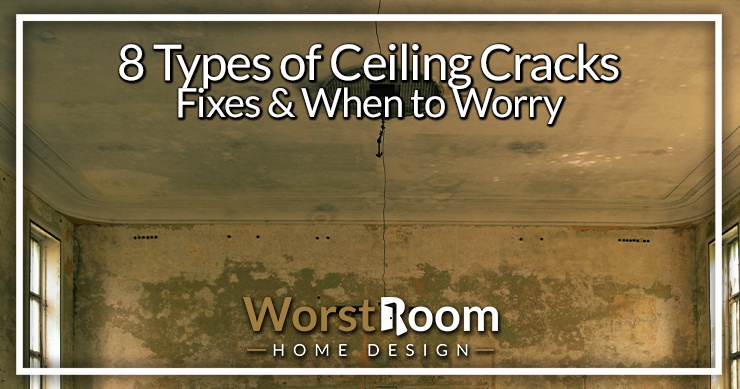
When a house gets older, it settles and loses some slight structural integrity and needs some emergency repairs. It's not like the house is going to fall or anything; rather, you might see imperfections like one of the types of ceiling cracks below.
Cracks in the ceiling is one of the most common occurrences, and you'll be surprised to know that there are many different types of cracks in ceiling drywall or plaster to deal with. Sometimes the problem is structural, or it can be the settling issue. Before you decide to fix the raptures, it's wise to know what you are working on.
Below, we will talk about all the categories of ceiling cracks to give you a clearer picture of the potential damage that can occur, or your house might already be suffering one.
8 Types of Ceiling Cracks & Possible Fixes
There could be several reasons behind the ceiling fractures. The worst thing is that when something like this comes, it's very much visible and might need an immediate fix. Ceiling raptures usually occur when the house gets old.
Sometimes it's a matter of inadequate craftsmanship that can lead to cracks, as many types of ceilings require a bit more finesse than others. In most cases, it is due to the settlement problem that can appear over time. Improper installation of drywall and moisture can also be blamed. Here are some common ceiling crack types…
Straight Cracks
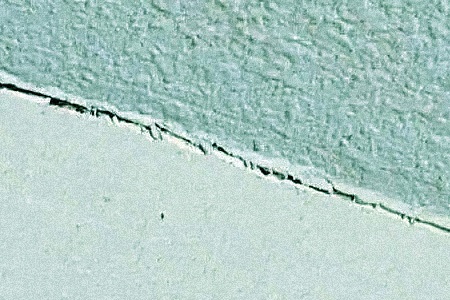
A straight crack is just what the name suggests. It appears in a straight line and might look like someone lined it up with a ruler. Why does it appear in a straight line? Well, the cracks follow the straight-lining of the drywall tape and might appear when the drywall tape fails to adhere to the drywall joint.
The simple reason behind this damage can be due to poor foundation settlement, which eventually leads to inadequate taping. All types of foundations settle over time, so don't panic. Straight cracks might appear when the taping of the drywall isn't up to the mark. This can be considered a human error rather than severe structural damage.
Luckily, these cracks in ceiling drywall are easily fixable, and a professional can patch them up. The ceiling will look great with a proper paint job later. If you're the one fixing it, you might have to replace the tape completely. Besides, patching the tape with drywall compounds and adhering it to the joints can be a workable solution.
To fix the crack, use a knife to loosen the old tape, then sand the surface beneath it. Affix the new tape and apply some drywall compound with a suitable knife. Make sure to spread it evenly and let it dry for a smooth and crack-free look.
Hairline Cracks
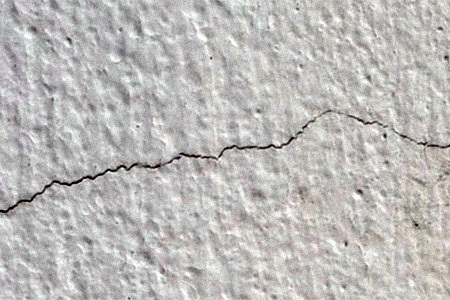
Just like the appearance of thin hair on a wall, hairline cracks imitate a similar outlook. These are tiny, thin cracks that sometimes can be hard to notice. A hairline crack usually appears when there is something wrong with the drywall mud.
When there is severe heat due to temperature changes in the weather, it can take a toll on your wall and ceiling without you realizing it until it's too late. The temperature rise is what makes the drywall shrink and expand, resulting in thin cracks that look like a hairline.
If you are worried about such damage, don't be upset, as it's not something that points toward structural damage. These issues can be fixed easily without any special tools or materials.
We have seen most homeowners avoid dealing with these types of ceiling cracks because they aren't the serious type and are mostly out of sight. To change the appearance, a layer of fresh paint is enough to counter the appearance of the cracks.
Discolored Cracks
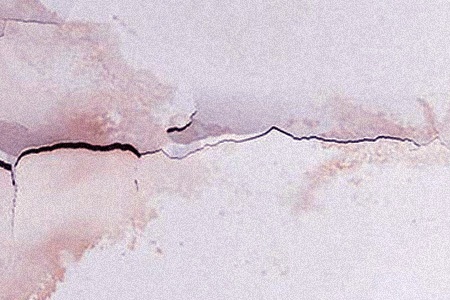
This kind of discolored appearance straightly points out water-induced damage on the ceiling. Yellow or brown cracks come to life whenever there is a leak from the top floor or the roof. A damaged pipeline can also allow water to come in contact with the ceiling, making them damp.
Thankfully, yellow or brown cracks aren't signs of severe damage to the structure. But, if not taken care of immediately, they can induce molds and mildew, which can damage the drywall completely. More importantly, these kinds of cracks look shabby due to discoloration and are certainly not pleasing to the eye.
To mend it, you must first dive into the probable causes. Check out the leaking areas and try to fix that first. For small areas of damage, it can be worked out by painting once the leak has been sealed. In case of larger affected areas, it's better to call a professional to scour and mend the ceiling in the best possible way.
Spider Web Ceiling Cracks
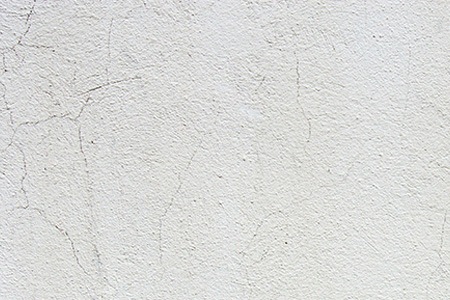
A spider web ceiling crack resembles spider nets and branches out in thin lines, propagating in several directions at once. This usually indicates a worn-out foundation settlement or a damaged structure.
You must know that with time every part of the home settles in, and sometimes the settlement can be uneven. This often exerts pressure on the foundation. Slowly the tension is transferred to the frame and the drywall system, which eventually weakens the surface, and cracks in the ceiling appear.
Spider web cracks can be a serious matter that has to be dealt with carefully under professional supervision, but if that's the case you'll notice much more severe problems elsewhere. If the crack is very small, for example, 1/16th of an inch, you might not need to worry. It could be a result of inadequate drywall mud filling.
For a simple fix, you can try to sand the poor patching compound and reapply a new layer to come up with an immaculate wall. These crawling cracks are usually superficial and happen due to the types of ceiling textures used, but please take the time once sanded to inspect the underlying surface.
Bowed Ceiling & Large Cracks
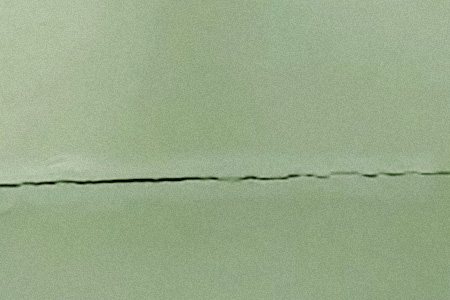
Let's talk about a crack that can be extremely dangerous for your ceiling structure if not repaired immediately. Have you ever seen large cracks appear in the middle of your ceiling, and sometimes the surface bows down as if it's about to fall? If yes, then you have a bowed ceiling, which points to severe structural damage.
Some signs of structural damage beyond these cracks in the ceiling drywall that you can investigate include popped nails or screws bulging out, flooring that has become uneven, bowing of walls, floors, or ceilings, and if you have any windows or doors that are shut and can't be opened (and you've ruled out other causes).
This can occur because of a faulty foundation settlement. Sometimes the load bearings on the ceiling are taken off without providing any balancing support. Eventually, it might result in large cracks.
A bowed ceiling can also appear when the overhead weight of the ceiling exceeds a certain limit. This causes the ceiling to lose its structural integrity and bow down. In such occurrences, it's vital to remove all the objects that are settling over the crack or whatever is under it.
There is a chance the ceiling can collapse due to a bowed end. You must not try to fix these types of ceiling cracks on your own. Better call an expert mechanic and let them pick out the best solution.
Cracks Between Wall & Ceiling
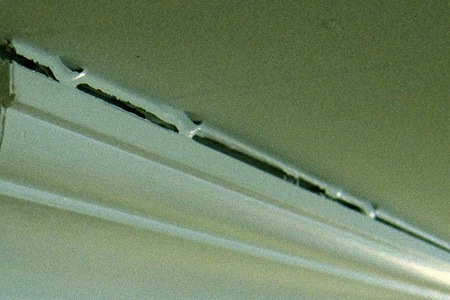
Separation cracks can be observed between the ceiling and wall surfaces. This is a direct result of truss uplift. As you might know, a truss provides the framing of the ceiling and makes up its shape.
Truss components are made to last and withstand harsh conditions, but in some cases, they can fail to function. For example, weather changes and extreme winds can dislocate the truss setting, pulling it away from the surface of the ceiling.
When trusses shift, you might observe the wall and ceiling exhibiting a large gap in between. Apart from that, incorrect installation of non-load bearing on drywalls can impose such cracks. To fix this issue, crown molding can be a good option. It's the fitting of decorative items where the ceiling meets the wall.
Don't try to mend these cracks on your own. It is ideal to seek help from a professional person and let them work magic.
Sagging Separations
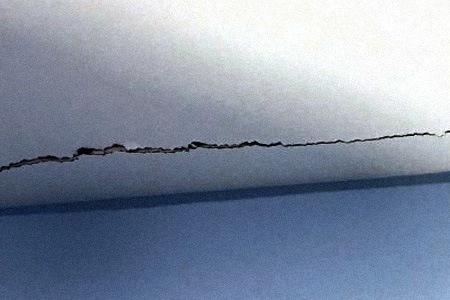
One of the most common types of ceiling cracks, sagging ceilings, appear in multi-storied buildings with flimsy drywall. Of course, those drooping drywall are very unpleasant to see. However, they also indicate moderate to severe structural damage.
Weak drywall material, rotted beams, excessive load, moisture, and a damaged foundation are the most common causes of sagging ceilings. If you're lucky, simply removing the excess weight and source of moisture can solve the problem.
Sometimes the damage is too severe and can only be solved by a professional approach. Whatever the scenario is, don't waste time if you notice a sagging ceiling, and act immediately before it spreads further.
Matching Vertical Cracks
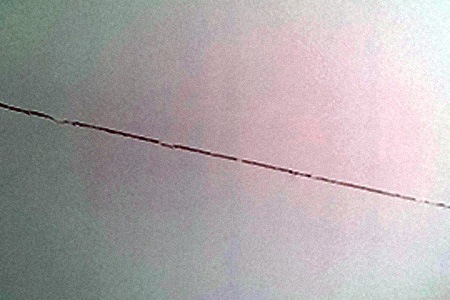
If you see a vertical crack running up the wall's drywall that then proceeds up to and on the ceiling, you need to be careful. This crack will be one continuous line and may even have cracked whatever types of crown molding you may have.
The main concern here is that you've possibly suffered structural damage. Yes, it can be from the settling of the foundation creating pressure across both surfaces, but you don't need to take the risk. You should hire a professional to inspect the home at this point.
The fix is as simple as using spackle or drywall joint compound, let the spackle dry, sand it flat, and paint back over it, but that doesn't need to occur until an inspection has been completed.
Types of Ceiling Cracks to Act on Now
Hairline cracks or straight cracks are pretty common. Such cracks don't indicate any major symptoms of structural damage. These can occur due to improper taping and drywall mud issues. You can easily solve these with paintwork and retaping the surface. If the problem persists, it's wise to seek help from a professional.
In case your house ceiling has spiderweb cracks or bowed areas, then you must immediately call an expert to deal with it. These occur due to structural damage and must not be taken lightly. The next time you observe any ceiling cracks, treat them immediately.
If you've gone through our guide about the different types of ceiling cracks, you'll be able to decipher the problem yourself. It's better to know what kind of cracks your ceiling is showcasing; only then you can talk to the mender for a fix or opt to do it yourself.



